ASUS' N82Jv: Jack-Of-All-Trades
by Jarred Walton on September 11, 2010 11:10 PM ESTASUS N82Jv-X2 General Performance
We've been through this before, and our test suite remains the same as in recent laptop reviews, so let's jump right in and see how the N82Jv fares. Two key matchups are highlighted in the charts: the M11x R2 that has the same GPU but a slower ULV CPU, and the Toshiba A660D that represents something of the high water mark for current AMD notebooks.
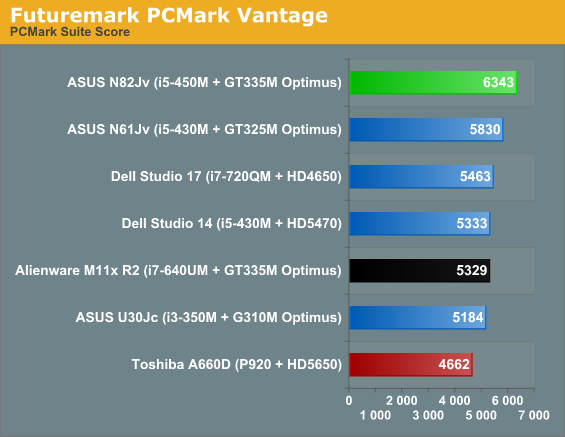
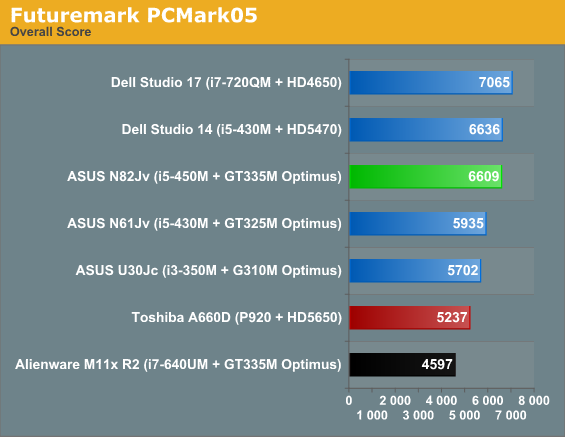
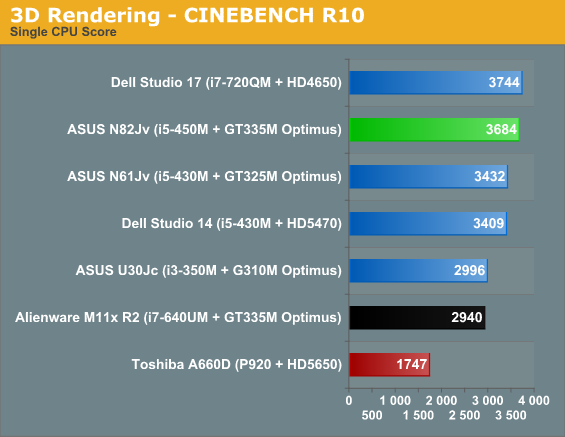

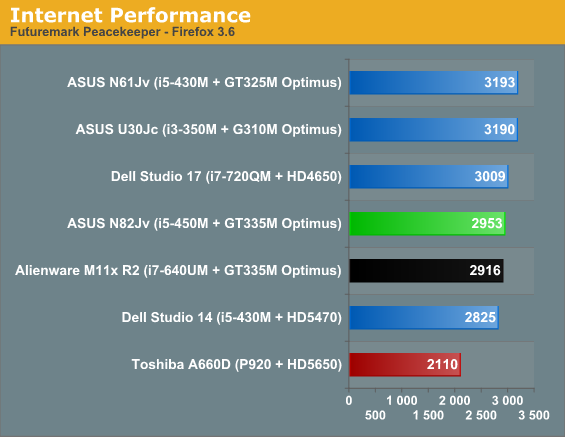
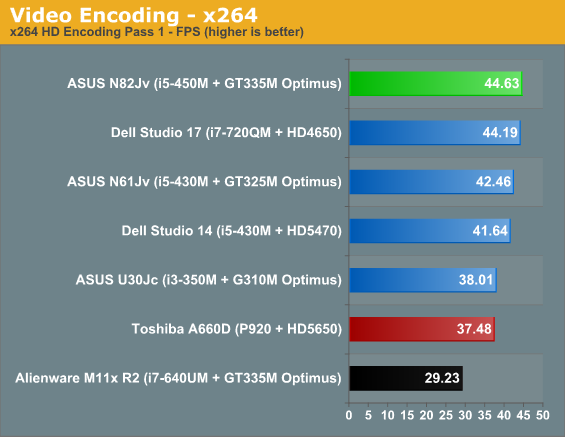
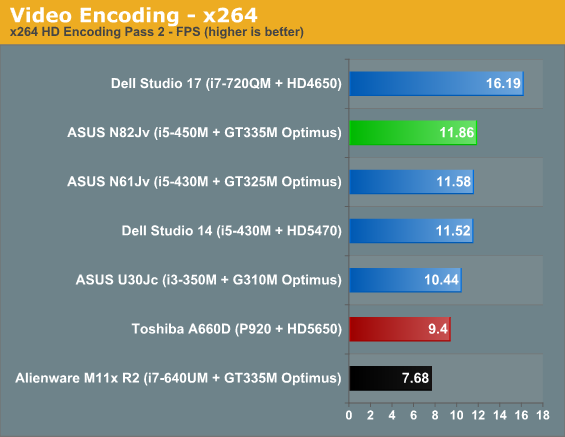
Right from the start, our two key comparisons show the N82Jv in a favorable light. Starting with the M11x R2, PCMark05 has the N82Jv leading the by 44%, while the Vantage result is "just" 19% higher. The close result of the M11x in Peacekeeper is an oddity…as is the loss to the slower clocked CPU/GPU of the N61Jv. It could be minor differences in the driver department, or perhaps the latest 3.6.8 Firefox updated reduced Peacekeeper performance. Regardless, we ran the test numerous times but the result was always lower than expected (and yet similar to the Studio 14). Peacekeeper is the exception to the rule, however. Cinebench gives the N82Jv a 25%/44% lead in the 1CPU/SMP tests, and the lead in x264 is just over 50% in both passes.
The comparison to the A660D leaves no question as to which processor is superior, with the lowest margin of victory coming at 20% in the first pass x264 encode—a test that's traditionally more HDD/bandwidth bound. PCMark has the N82Jv ahead by 36% in Vantage and 26% in 05, Peacekeeper gives the N82Jv a 40% lead, the single CPU Cinebench result is more than twice as fast as the P920, and the lead in multi-threaded tasks ranges from 20% to just over 30%. This is something we pointed out in the A660D review: when AMD's quad-core P920 can't come up with some clear wins over the i3-330M, it's a tough sell. Obviously, the i5-450M is faster than the 330M and simply increases Intel's lead; AMD's 2.0GHz N930 should come a lot closer to the Intel results in multi-threaded applications, but anything slower than that really needs to go after the value proposition.
Looking at the nearly identically equipped (outside of the GPU) Dell Studio 14, the N82Jv places about where we'd expect. The Vantage result favors ASUS by 19%, PCMark05 is a tie, but the remaining tests all give ASUS a lead of around 5% (give or take). It looks like ASUS has managed to better optimize the system performance, either with tighter memory timings, more BIOS tuning, or other tweaks. 5% is hardly anything to get worked up about, but it does show ASUS pays attention to some areas of performance more than many larger OEMs. $100 more for better performance, a significantly faster GPU, plus Optimus and USB 3.0 on top of that? Unless you can get the Studio 14 for a lot less than $900 for our tested system, the N82Jv is clearly a better choice.










33 Comments
View All Comments
JarredWalton - Sunday, September 12, 2010 - link
I guess I *heard* about the Envy 14 (or the old Envy?) six months back. Here's hoping it will still arrive soon....Roland00 - Sunday, September 12, 2010 - link
4 months is a life time in the computer world though. Almost every series gets a refresh every quarter.Now the old envy were 13 inch and 15 inch. They were released during Oct 09 to coincide with the windows 7 launch. While I praise HP vision they didn't really sell well in stores due to the fact they were expensive (starting at 2000+ at the time), had no optical drive (which I see as a benefit but some customers couldn't understand) and the 15 inch cold get very hot. The 13 inch was designed to be fast enough with a culv or lv processor and 4330 video card and up to 14 to 18 hours of battery life (depending on configuration, measured in mobilemark, a bad test I know.) How it obtain this battery life is it had a standard 4 cell battery but it also had a detachable 6 cell battery that was the entire width and length of the laptop so if you attached the battery it is just like the laptop got thicker. The envy 15 inch had the same philosophy with the battery but it instead packed a quad core, a 1080p screen, either a 4830 or 5830 (depending on refresh), and up to 16gbs of memory. On paper, the first envys were trying to be a windows macbook pro that were either trying to be faster (competing against 15 or 17inch) or had better battery life (competing against 13 inch and macbook air).
Now I been more impressed with the 14.5 inch and the 17 inch for while they may be bigger and heavier due to the optical drive, they are trying to be more "balanced" via having more moderate price options available at the start.
blackrook - Monday, September 13, 2010 - link
How does it all work? Do they send products to you spontaneously, or is it agreed upon by both you guys and the companies?I'm intrigued with what you guys would think of it...even though I already bought it. Almost like a reassurance that I've made a solid decision, heh.
Fingers crossed.
JarredWalton - Monday, September 13, 2010 - link
Either they contact us or we contact them, trying to get products for review. Some companies are more than happy to send products out (i.e. ASUS) while others seem to sample few if any products.mrmbmh - Sunday, September 12, 2010 - link
Hi,very nice article! thx Jarred!There are some popular notebooks you've not reviewed yet..... like U45jc Asus and HP dm4 (light-weight 14"s)
Can you review them or at least join them into LCD comparison benchmark?
Thanks.... : )
zoxo - Monday, September 13, 2010 - link
You can be assured that the LCDs are utter crap on those too. The Envy from hp seems to be a step up, but it doesn't have matte option. What a shame!Akv - Sunday, September 12, 2010 - link
The proportion of gamers in the comments of reviews websites is almost 100%, but that is not the proportion of users, who might for example prefer a reduction of price in exchange for graphics just sufficient for productivity and video. Or the same price with an increase of storage, of silence instead of gaming, etc.The divergence between users when it comes to laptop is even stronger, so much so that I would not be surprised if the proportion of users who want gaming on a laptop was insignificant, although still of course quasi 100% of reviews websites comments.
I regret that, on this website as many others, the heat and noise are not even evoked, whereas it seems to me the main element of the build quality for a laptop.
I was interested by the expertise on LCD quality. If I have to pay for a laptop I really want to display photos correctly, and to be able to read comfortably. I would be ready to accept less horsepower in exchange for better display. I would not even refuse an atom netbook with a perfect matte screen.
seanleeforever - Monday, September 13, 2010 - link
that, my friend, is a good comment.i too overly frustrated with all the gamer's comments with cares nothing except GPU and CPU. there is much more to a laptop than play games. (besides, you shouldn't play games on notebook anyway)
if the image is the key, consider the following as rule of thumb.
best :IPS/AFFS+ screen, they are the best (lenovo X201 Tablet, HP dream color)
second to the best: MVA screen in Fujitsu T5010
distant third is 8-bit TN panels w/ RGBLED backlight (Alienware and Dell Precision M6500)
distant forth is 6-bit TN panels w/ RGBLED (Dell M4500, sXPS16, Lenovo T/W510, W701/ds, Apple MBP (15-17"))
you would also need to consider the heat, noise, fan position, key layouts, which is something anand will never cover in detail because it doesn't sounds as cool as GT335M.
JarredWalton - Monday, September 13, 2010 - link
It's not a case of it "sounding as cool"; there just isn't much to say that's noteworthy. If the laptop is particularly loud and/or hot, we'll make a note of it, but the N82Jv is basically "average" (or perhaps even below average) in these areas. That comes form the components, with the HD 5650 and GT 335M built to hit specific TDPs so they can fit in laptops. If you're not doing anything taxing, the N82Jv runs cool enough that there's no worry. At load, fan speeds ramp up and it gets warmer.Vivek and Dustin don't have the necessary tools for testing power/temp/noise, so I haven't been focusing on those in order to keep the reviews consistent. But since you asked, the N82Jv runs at around 70-80F temperatures (give or take) idle, and bumps up 5-10F under load. The keyboard and palm rest tends to be a bit cooler than the bottom, though certain areas get hotter than others, naturally. The hottest spot I found under load was on the bottom under where the GPU sits, and it was 105F.
Noise levels are basically at the limit of my SPL meter at idle (30dB), but under load it can get noisier. I measured 39 dB(A) at a distance of about 12". So as a whole, this is good and certainly nothing I would consider problematic. I'm far more concerned with the plastic chassis and low quality LCD on the N82 than I am with the heat/noise.
The Crying Man - Monday, September 13, 2010 - link
You guys could all use HWMonitor or GPU-Z at least to give us an idea of temps at idle or load.